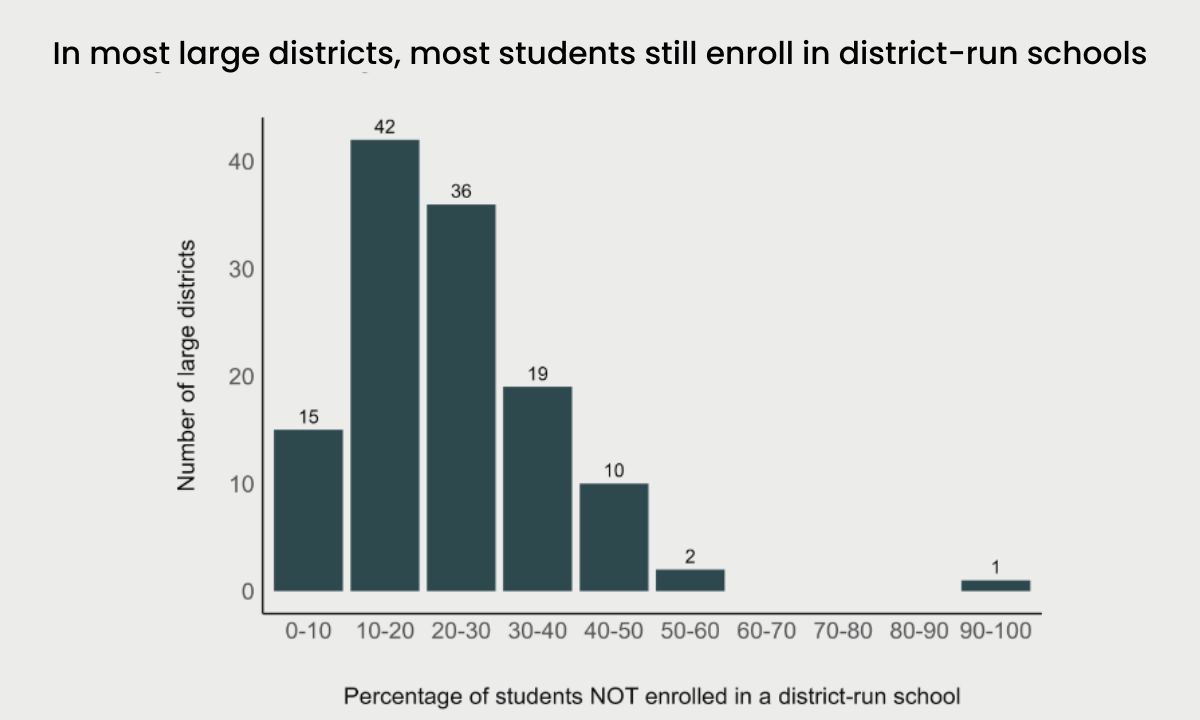New Analysis Finds Charter School Sector Still Has Plenty of Room to Grow
Petrilli: Most large districts are far from saturated with options — especially for kids of color, who are often poorly served by traditional schools.

Get stories like this delivered straight to your inbox. Sign up for The 74 Newsletter
The conventional wisdom in some quarters is that the charter school movement has run its course. Abandoned by an increasingly progressive Democratic Party for being “neo-liberal” and by an increasingly populist Republican Party for being “technocratic,” charter schools (the story goes) are falling into the chasm that has opened up in the political center of our ultra-polarized country.
But the conventional wisdom is wrong.
Yes, the politics around public charter schools have become more challenging, especially in the blue-hued cities where most of the media lives and works. But across vast expanses of urban and semi-urban America, and especially in Black and brown communities where charter schools have proven most popular and effective, there’s still plenty of room to grow, and few policy barriers standing in the way.
That’s one key takeaway from a new analysis by my colleagues David Griffith and Jeanette Luna at the Thomas B. Fordham Institute, The Education Competition Index: Quantifying competitive pressure in America’s 125 largest school districts. The median large district in the U.S. still serves upward of 80% of its resident students, with the other kids attending charter schools, private schools or home schools. That means that most large districts, including highly urban ones, are far from being saturated with options — especially for families of color, who generally are poorly served by traditional public schools. This makes them promising locales for further charter expansion.
I say “charter expansion” for several reasons. First, of the many alternatives to traditional public schools, charter schools have by far the strongest track record when it comes to boosting student achievement, especially for low-income children and students of color. A growing body of research, including a recent study from CREDO at Stanford University, shows charter school students outpacing their traditional public school peers both on test scores and on long-term outcomes such as college completion, especially in urban areas. In contrast, private school choice programs have been markedly less effective in boosting student outcomes, at least as judged by test scores. Recent studies of large-scale voucher programs in Ohio, Indiana and Louisiana all show recipients trailing their public school peers on test score growth, sometimes significantly.
Second, compared with private-school choice initiatives, the charter movement has proven much more capable of growing its market share. Whereas only about 770,000 students currently receive publicly funded scholarships or savings accounts — many of which cover just part of the price of schooling — more than 3.6 million pupils attend charter schools. And as the study found, during the 2010s, the rising tide of competition that most large school districts faced was almost entirely attributable to charters.
Another recent analysis, this one from the National Alliance for Public Charter Schools, supplies further evidence of charters’ staying power and potential for growth. Whereas enrollment in traditional public schools shrank by 3.5% during the pandemic era, charter school enrollment grew by 9%. The increase was particularly explosive among Latinos.
So where do charters have the most growth potential in the years ahead? Our analysis shows that most likely hotspots are in urbanized or rapidly urbanizing areas that are home to many students of color, who tend to be best served by these high-impact schools. More specifically, we believe that moving forward, philanthropists, national charter networks and advocates should consider three key factors:
- Policy. It’s hard to open charter schools in hostile environments, such as those with paltry funding or strict charter caps. Conversely, new investments in equitable per-pupil funding or facilities are akin to placing a big “we’re open” sign at state (or municipal) borders.
- Room to grow. In the handful of places where more than half of students already exercise school choice, the market for educational alternatives is arguably saturated. But these are exceptions.
- Momentum. While past results are no guarantee of future performance (as mutual funds are required to say), states where charters are growing are likely to see further growth in the coming years — provided the movement can avoid legislative setbacks.
Put those variables together, and the following states emerge as especially promising places where investments in continued charter growth might do the most good:
- Texas. The Lone Star State has enjoyed strong charter growth, with enrollment up 7% from a year ago and 20% since before the pandemic. Yet there’s still plenty of room to run. While Houston, Dallas and Austin have long hosted lots of great charter schools, it’s still the case that 70% to 75% of children living in those cities attend district schools. And there’s even less school choice in smaller districts like Fort Worth, El Paso and Northside, in San Antonio, all of which have significant and growing Hispanic populations.
- North Carolina. The Tarheel State boasts a 19% charter growth rate since 2019 and shows no signs of slowing down, thanks to a new statewide charter authorizer. Yet 85% to 90% of students in the counties that are home to Winston-Salem, Fayetteville and Greensboro attend district schools.
- Nevada. The Silver State’s two large districts, Clark County (Las Vegas) and Washoe (Reno), are among the biggest prizes on the map. Together, they serve almost 400,000 kids, yet just 16% (in Vegas) and 12% (in Reno) attend non-district schools. The legislature just created a new independent charter authorizer, which should supercharge Nevada’s charter growth, which is already up 19% since before the pandemic.
Those are just the standouts. Plenty of other states and local communities are good bets, too. Ohio, Indiana and Wisconsin all recently enacted major funding increases for charter schools, and have hospitable environments. The suburbs around Denver and Atlanta serve a growing number of students of color and yet offer limited educational options. Population booms and strong charter policies in Florida and Tennessee make them welcoming jurisdictions.
So, to potential supporters who think the charter opportunity has passed them by, I say: Think again. There are lots of students, families and communities that are still in dire need of great educational options. Let’s make sure they get them.
Get stories like these delivered straight to your inbox. Sign up for The 74 Newsletter

;)
